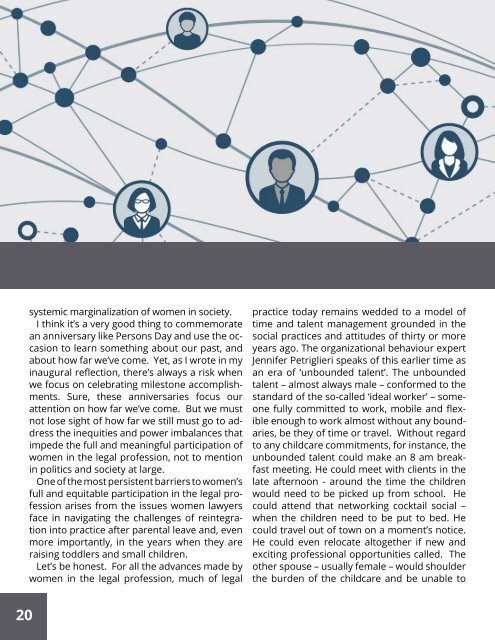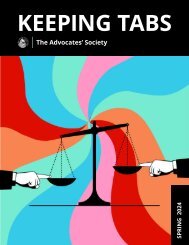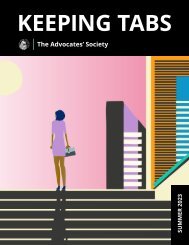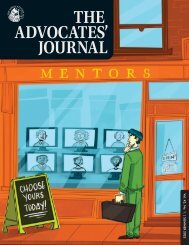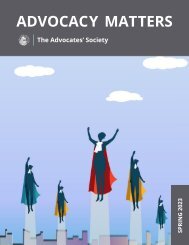Advocacy Matters - Fall 2019
Keep up to date on what your fellow Society members have to say in Advocacy Matters.
Keep up to date on what your fellow Society members have to say in Advocacy Matters.
Create successful ePaper yourself
Turn your PDF publications into a flip-book with our unique Google optimized e-Paper software.
systemic marginalization of women in society.<br />
I think it’s a very good thing to commemorate<br />
an anniversary like Persons Day and use the occasion<br />
to learn something about our past, and<br />
about how far we’ve come. Yet, as I wrote in my<br />
inaugural reflection, there’s always a risk when<br />
we focus on celebrating milestone accomplishments.<br />
Sure, these anniversaries focus our<br />
attention on how far we’ve come. But we must<br />
not lose sight of how far we still must go to address<br />
the inequities and power imbalances that<br />
impede the full and meaningful participation of<br />
women in the legal profession, not to mention<br />
in politics and society at large.<br />
One of the most persistent barriers to women’s<br />
full and equitable participation in the legal profession<br />
arises from the issues women lawyers<br />
face in navigating the challenges of reintegration<br />
into practice after parental leave and, even<br />
more importantly, in the years when they are<br />
raising toddlers and small children.<br />
Let’s be honest. For all the advances made by<br />
women in the legal profession, much of legal<br />
practice today remains wedded to a model of<br />
time and talent management grounded in the<br />
social practices and attitudes of thirty or more<br />
years ago. The organizational behaviour expert<br />
Jennifer Petriglieri speaks of this earlier time as<br />
an era of ‘unbounded talent’. The unbounded<br />
talent – almost always male – conformed to the<br />
standard of the so-called ‘ideal worker’ – someone<br />
fully committed to work, mobile and flexible<br />
enough to work almost without any boundaries,<br />
be they of time or travel. Without regard<br />
to any childcare commitments, for instance, the<br />
unbounded talent could make an 8 am breakfast<br />
meeting. He could meet with clients in the<br />
late afternoon - around the time the children<br />
would need to be picked up from school. He<br />
could attend that networking cocktail social –<br />
when the children need to be put to bed. He<br />
could travel out of town on a moment’s notice.<br />
He could even relocate altogether if new and<br />
exciting professional opportunities called. The<br />
other spouse – usually female – would shoulder<br />
the burden of the childcare and be unable to<br />
be ‘unbound’ such that she would not have the<br />
same chances for advancement.<br />
Most law firms still place a premium on a culture<br />
of ‘facetime’ – of being physically present<br />
in the office, 9-to-5 as the saying goes (granted,<br />
and realistically, much longer) and able<br />
to handle hours outside of a child’s school or<br />
daycare hours.<br />
We need to ask ourselves: how do the demands<br />
of being seen in the office square with<br />
the lived experience of women in the law who<br />
are navigating a return to work after parental<br />
leave and with small children? How realistic<br />
is it to expect her to make it to that breakfast<br />
meeting? Even if she has a supportive partner<br />
at home, or adequate (if costly) childcare<br />
arrangements, is it a sound strategy of talent<br />
management to insist on physical presence<br />
that punishes her for having to leave the office<br />
early each day to pick up her child; or for<br />
cancelling a meeting because her child is home<br />
sick from school? These expectations disproportionately<br />
disadvantage women, ostracizing<br />
an enormous part of the talent pool. This does<br />
no one – not women in law, and not the firms<br />
or clients – any good.<br />
The important point is this: in the digital age<br />
in which we live, it doesn’t make sense to cling<br />
to outdated conventions and unnecessary practices.<br />
We need to insist on changing workplace<br />
structures and effecting change in the cultures<br />
that undergird them.<br />
The digital technologies of today have<br />
changed the practice of law. With that comes<br />
new challenges, but also new opportunities.<br />
The speed, efficiency and security with which<br />
information and communication occurs<br />
makes it entirely possible to give people flexibility<br />
to get work done ‘off-site’. What matters,<br />
ultimately, is that it gets done and done<br />
well. It’s the output that matters more than<br />
where the work gets done.<br />
Frankly, the model of the 10- or 12-hour workday<br />
in the office is, for many professions like<br />
law, a relic. My own productivity has improved<br />
enormously through a practice called split-shift.<br />
Most evenings, I’m home for supper and then I<br />
return to work – remotely – in the evening, once<br />
my five-year old has gone to bed. And while I’m<br />
always keen to take on assignments outside the<br />
office and out-of-town, I need reasonable notice<br />
to make sure childcare can be arranged.<br />
I believe this is less about achieving that elusive<br />
‘work-life’ balance, and more about insisting<br />
that professional practice respond to<br />
the realities, and to the opportunities, created<br />
by the technological and social changes of our<br />
day. With the value placed on what is important<br />
– quality and quantity of work, not location.<br />
All of which means demanding flexible, equitable<br />
and, above all, productive work arrangements.<br />
The key is to work smartly, efficiently,<br />
and in a manner that allows women to realize<br />
the full potential of their talent – not just the<br />
work they do, but also the advancement and rewards<br />
for that work. The goal, after all, is to enable<br />
professional achievement while promoting<br />
personal well-being; it’s about talent unleashed<br />
rather than unbound.<br />
20 21


